|
|
|
Sort Order |
|
|
|
Items / Page
|
|
|
|
|
|
|
| Srl | Item |
| 1 |
ID:
161704
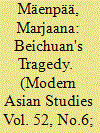

|
|
|
|
|
| Summary/Abstract |
It has been argued that Tan Zuoren's essay ‘Longmen Mountain, please bear witness for the children of Beichuan’ is not only an attempt to narrate an alternative version of the story of the Wenchuan earthquake but also to present a vision of an alternative future for Chinese society. The building blocks for this alternative future would be finding a balance between human beings and nature, respect for minorities, and responsible rule. Tan does not demand the end of Communist Party rule, but explains how the system could be changed to make it better for both the people and nature. The keys to achieving this goal are rectifying historical injustices, an honest examination of mistakes, and respect for ordinary people.
|
|
|
|
|
|
|
|
|
|
|
|
|
|
|
|
| 2 |
ID:
132953
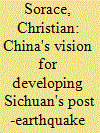

|
|
|
|
|
| Publication |
2014.
|
| Summary/Abstract |
In the aftermath of the 2008 Wenchuan earthquake, government officials, scholars and outside observers eagerly hoped that the emergency relief and reconstruction process would bring about the emergence of civil society and increase grassroots democratic participation. Contrary to this optimistic assessment, this article contends that the local state used the opportunity of the disaster as an experimental laboratory to implement an array of already existing national development plans. The urgency with which the reconstruction was to be completed and the opportunities to meet national development targets as well as access reconstruction funds were too tempting to resist. However, the ham-fisted Leninist implementation style met with local resistance and has contributed to a significant deterioration in local state-society relations. The fact that many local residents continue to question why, despite the huge resources invested by the state in the reconstruction project, they have yet to see any improvement in their economic and overall living conditions points to a deficit of local participation and a breakdown in political communication and trust. By focusing on the different political economies of disaster reconstruction, this article attempts to illuminate the regime's vision for developing the countryside, rural politics, and state-society relations in China more broadly. Unless the state is able to incorporate local needs into its development plans, it will not win the trust and support of local residents, regardless of the amount of money it invests or the benevolence of its intentions.
|
|
|
|
|
|
|
|
|
|
|
|
|
|
|
|
| 3 |
ID:
171720
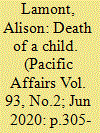

|
|
|
|
|
| Summary/Abstract |
Within the institution of family welfare in the People's Republic of China, the role of the child as future caregiver is so deeply institutionalized as to be almost invisible to policy makers and family members. This article explores institutional responses to the death of a child after the 2008 Wenchuan earthquake to demonstrate how this taken-for-grantedness of the child caregiver role has opened up bereaved parents to social risk, and how actors must perform institutional work to "repair the breach" of the loss of a child in a family. Findings show that after the 2008 Wenchuan earthquake, policy actors took steps to manipulate entrenched family welfare resources, including the population and family planning regulations, to enable bereaved parents to have another child. In so doing, they sought to patch and restore meaning to the family welfare institution, enabling it to continue autopoiesis and resist institutional change in the face of exogenous shock. Use of policy and the positive representation of the policy outcomes in the state-led media enabled sensegiving to be imbued into an otherwise emotionally conflicted decision to try to conceive again soon after the loss of a child.
|
|
|
|
|
|
|
|
|
|
|
|
|
|
|
|
| 4 |
ID:
102993
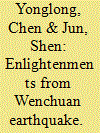

|
|
|
| 5 |
ID:
156522
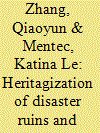

|
|
|
|
|
| Summary/Abstract |
This article discusses state-led heritagization processes in Beichuan and Wenchuan Counties, two Qiang ethnic minority areas severely affected by the 2008 Wenchuan earthquake (China). Certain destroyed landscapes were preserved and turned into earthquake relic sites. In particular, the former Beichuan County seat was entirely heritagized for memorial, economic, and patriotic education purposes, causing an emotional conflict with locals still affected by loss and trauma. At the same time, Qiang cultural practices were hastily registered as national and international intangible cultural heritage, while reconstructed Qiang villages were transformed into heritage tourism destinations. These initiatives tend to reshape Qiang culture elements into fetishized commodities. Allocating massive funds to historically marginalized regions, these post-disaster heritagization programmes aimed at boosting economic recovery, as well as demonstrating state power, national unity and solidarity. Implemented using a top–down method, they appear insensitive to the affected population’s trauma and the sociohistorical context from which the newly heritagized elements originate. The disaster and Qiang culture heritage tourism not only failed to bring about sustainable economic development to the earthquake-stricken areas, but also ignored to a large extent the initial goal of ‘post-disaster cultural recovery’ and the virtues of cultural heritage in recovery processes.
|
|
|
|
|
|
|
|
|
|
|
|
|
|
|
|
| 6 |
ID:
110016
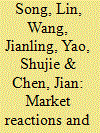

|
|
|
|
|
| Publication |
2012.
|
| Summary/Abstract |
This paper studies the market reactions to corporate philanthropic giving in response to the 12 May 2008 Wenchuan earthquake in Sichuan, China. Based on a sample of 136 Chinese listed companies, our results indicate a significant and positive seven-day cumulative abnormal rise in the share prices of those companies making donations compared to those not making donations. Both timeliness and the amount of philanthropic giving generate significant market reactions, confirming Godfrey's assertion that corporate philanthropy can be perceived as a genuine manifestation of firms' underlying desire to raise their market values. However, when the sample firms are divided into two groups, government controlled and non-government controlled, Godfrey's assertion is challenged by our empirical results which show different market responses to the two different types of companies.
|
|
|
|
|
|
|
|
|
|
|
|
|
|
|
|
|
|
|
|
|